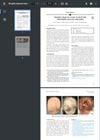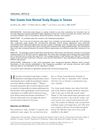TLDR Both trichoscopy and folliscopy accurately diagnose telogen effluvium, but trichoscopy is easier and faster.
The study, involving 100 adult participants with telogen effluvium (TE), aimed to assess and compare the effectiveness of trichoscopy and folliscopy in diagnosing TE. The results showed that the presence of more than 5% new regrowing anagen hair is a definitive diagnostic sign of TE by both methods. Other signs such as empty hair follicles, single hair follicles, and peripilar halo were also found in TE patients. The study concluded that both trichoscopy and folliscopy are highly accurate and sensitive diagnostic tools for TE, but trichoscopy has the advantage of being easier and less time-consuming than folliscopy.
 1 citations
,
August 2022 in “JAAD case reports”
1 citations
,
August 2022 in “JAAD case reports” Tofacitinib and oral minoxidil may help treat Sisaipho alopecia areata.
11 citations
,
September 2021 in “Skin Appendage Disorders” Hair count values should be standardized for each scalp region to evaluate hair disorders in Asians.
 6 citations
,
December 2014 in “Clinical and Experimental Dermatology”
6 citations
,
December 2014 in “Clinical and Experimental Dermatology” Hair density and thickness decrease in all scalp areas for East Asians with AGA.
 58 citations
,
September 2012 in “Dermatologic Clinics”
58 citations
,
September 2012 in “Dermatologic Clinics” Male pattern hair loss caused by follicular miniaturization; early diagnosis and treatment can reduce psychological burden.
 24 citations
,
September 2012 in “Dermatologic Surgery”
24 citations
,
September 2012 in “Dermatologic Surgery” The conclusion is that normal scalp hair counts for Taiwanese people were established, showing age-related differences but not sex or scalp location differences.
 6 citations
,
August 2006 in “Journal of Cutaneous Pathology”
6 citations
,
August 2006 in “Journal of Cutaneous Pathology” Two teenage brothers had a rare, treatment-resistant form of female-pattern hair loss with unusual scalp changes.
January 2001 in “대한피부과학회지” Horizontal sectioning helps diagnose hair loss, but Korean follicle differences matter.





